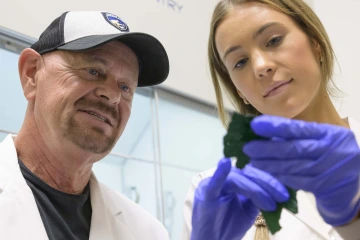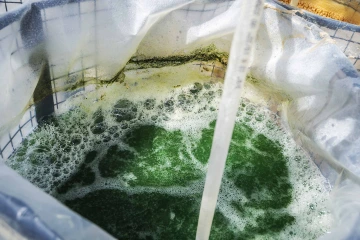Exploring a microbial solution to food insecurity
A University of Arizona Health Sciences-funded project is focusing on spirulina as a way to address food insecurity and mitigate the effects of climate change.
A mother rushed into the tent with a child in her outstretched arms. The four-year-old girl weighed just 12 pounds and was in critical need of a doctor.

Joel Cuello, PhD, a globally recognized expert in the engineering of sustainable biological and agricultural systems, is overseeing the bioreactors for the University of Arizona Health Sciences’ spirulina project.
Photo by Noelle Haro-Gomez, U of A Health Sciences Office of Communications
The tent belonged to Floyd “Ski” Chilton, PhD, who was working with a nonprofit to establish a safe zone for people fleeing the Darfur Genocide in Africa during the early 2000s. The mother heard he was a medical doctor, but his doctorate was in biochemistry.
“The child’s name is Abuk. I squeezed a therapeutic food that I had mixed together from ingredients in my backpack into her mouth every day,” Chilton said. “She survived, and I’ve been back to Darfur and visited Abuk.”
This was one of many times Chilton witnessed the effects of hunger and starvation on a child.
“We are facing an existential crisis,” said Chilton, who is a professor and the director of the Center for Precision Nutrition and Wellness in the School of Nutritional Sciences and Wellness at the College of Agriculture, Life and Environmental Sciences. “The world population will be around 10 billion people by 2050. That means we need to increase food production to feed those people. And we must do that in the face of climate change, which is reducing our capacity.”
Chilton and Joel Cuello, PhD, a professor in the Department of Biosystems Engineering at the College of Agriculture, Life and Environmental Sciences, are collaborating on a project that could provide nutrition to people in areas of food insecurity while addressing some of the challenges posed by climate change. The project, funded by the University of Arizona Health Sciences, revolves around a blue-green algae-like microorganism known as spirulina.
“Climate change is such a large, multifaceted problem with many impacts on human health,” said Michael D. Dake, MD, senior vice president for the U of A Health Sciences. “We looked across the university to find opportunities to collaborate, and the spirulina project has exciting potential to make a difference around the world.”
Growing a superfood in a changing climate
Around 733 million people faced hunger in 2023, equivalent to 1 in 11 people globally and 1 in 5 in Africa, according to the latest State of Food Security and Nutrition in the World report published by five United Nations specialized agencies. The report highlights that access to adequate food remains elusive for billions. In 2023, around 2.33 billion people globally faced moderate or severe food insecurity, a number that has not changed significantly since the sharp upturn in 2020 amid the COVID-19 pandemic. Among those, over 864 million people experienced severe food insecurity, going without food for an entire day or more at times.
Spirulina is an alternative protein source that grows naturally on the surface of lakes and ponds. It needs little more than sunlight, water and carbon dioxide to proliferate. It can be grown efficiently in vessels known as bioreactors, which provide a controlled environment for bacteria or cells to be cultivated to create useful products such as foods, vaccines and biofuels.

Floyd “Ski” Chilton, PhD, a pioneer in the areas of precision nutrition and wellness, is working to address nutritional deficiencies in global populations by creating a spirulina ready-to-use food product with far-reaching health and environmental benefits.
Photo by Kris Hanning, U of A Health Sciences Office of Communications
“Spirulina is great because it doesn’t require a lot of land or fresh water. In fact, it consumes carbon dioxide and puts oxygen back into the atmosphere. So, it has a reverse effect on greenhouse gasses,” said Chilton, who explained that while spirulina is often referred to as a blue-green algae, as a microorganism with no nucleus it is more accurately classified as a type of cyanobacteria.
Spirulina is rich in protein, vitamins, minerals and antioxidants and has long been touted as a superfood by health enthusiasts. In developed countries, it is used in many nutritional supplements and credited with several health benefits, including regulating blood sugar, lowering cholesterol and inflammation, reducing blood pressure and increasing the growth of good microbes in the gut.
The spirulina Chilton and Cuello are growing is 78% protein per dry weight, which is a higher amount than many nutritional supplements currently on the market. Proteins, which are made of amino acids, are critical to human health and are needed to help the body repair cells and make new ones.
Protein malnutrition, also known as protein-energy malnutrition, is a critical global issue that affects hundreds of millions of people and can be especially severe in vulnerable populations such as children, pregnant women and the elderly.
Chilton and Cuello’s goal is to develop a simple and inexpensive method of growing spirulina that could be implemented in poor regions facing food insecurity. They hope to optimize spirulina’s potential as a food-medicine product, similar to the therapeutic food Chilton provided Abuk. To that end, they are establishing a complete nutritional profile of the spirulina they grow by working with outside companies to determine the protein and amino acid content and testing the fatty acid content in Chilton’s lab.
“Not only is spirulina high in protein, but it is a complete source of nine essential amino acids,” Chilton said, explaining that the body makes some of its own amino acids, but nine can only be obtained through diet. It is also the richest known source of a vital essential fatty acid. “For a plant-based food, spirulina is simply miraculous.”
Defining production, testing and distribution
Bioreactors come in many forms and are typically made from stainless steel, glass or plastic. Inside this controlled environment, living cells, bacteria or other microorganisms can be grown and maintained.

The bubbles in this bubble reactor deliver oxygen and carbon dioxide and help mix nutrients that have been added to promote spirulina growth.
Photo by Noelle Haro-Gomez, U of A Health Sciences Office of Communications
“We didn’t want to use any patented or original designs, because we wanted these bioreactors to be simple in design, simple to operate and able to be affordably built using locally available materials,” Cuello said. “We want the local population to be able to build them, repair them and operate them.”
The research team tested and compared the merits of two common bioreactors and ultimately chose a bubble-column design.
The bubble column is about as simple as a bioreactor can get. It is an empty, vertical cylinder with no internal mechanisms except for a device that blows air into the liquid inside, creating bubbles. The bubbles deliver oxygen and carbon dioxide and help mix nutrients that have been added to promote spirulina growth.
Cuello views bioreactors as more than just an efficient tool for cultivating a food product. For nearly three decades, he has been researching ways to overcome the challenges climate change places on agriculture. He believes bioreactors, vertical farming and indoor agriculture are clear paths forward.
“We are already in the era of a changing climate, and it has resulted in significant disruptions to weather patterns around the world. It throws off the normal planting and harvesting schedules, not to mention the fact that times of excessive rain and long droughts kill crops,” he said. “But by operating in a controlled environment, like we do with our bioreactors, agriculture is more sustainable and can be done 365 days a year.”
Once Chilton and Cuello have a viable food product, they plan to work with global collaborators to design a clinical trial focused on improving the health and nutrition of severely malnourished children.
Chilton and Cuello envision a future where their production process can help mitigate the threats of climate change and malnutrition, their bioreactors can be used to protect developing countries from gaps in nutrition, and their food ingredients and therapeutic food products can be delivered to the people who need it most to eliminate food insecurity around the world.
Experts
Floyd “Ski” Chilton, PhD
Professor, School of Nutritional Sciences and Wellness, College of Agriculture, Life and Environmental Sciences
Director, Center for Precision Nutrition and Wellness
Member, BIO5 Institute
Joel Cuello, PhD
Professor, Department of Biosystems Engineering, College of Agriculture, Life and Environmental Sciences
Director, Global Initiative for Strategic Agriculture in Dry Lands
Member, BIO5 Institute
Contact
Brian Brennan
U of A Health Sciences Office of Communications
520-621-3510, brianbrennan@arizona.edu

